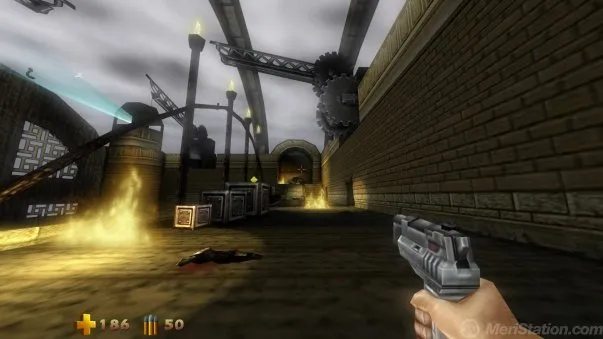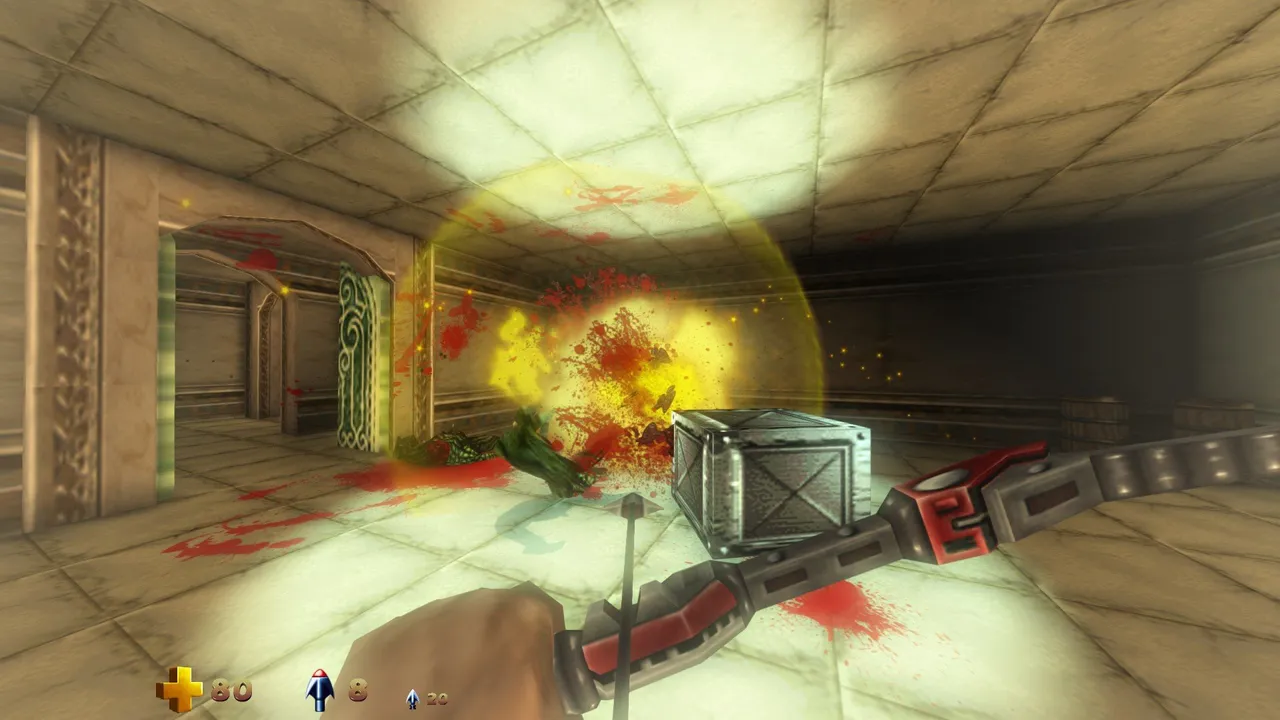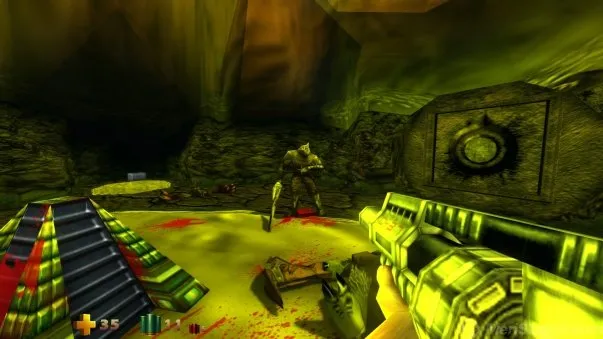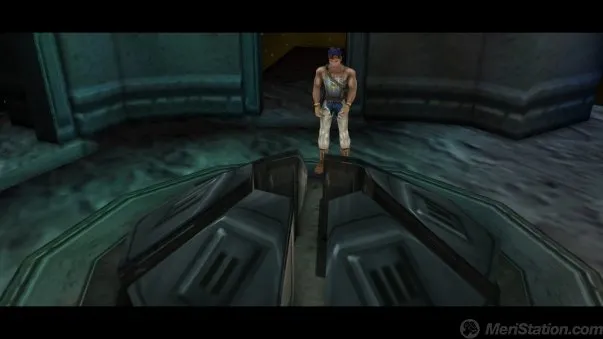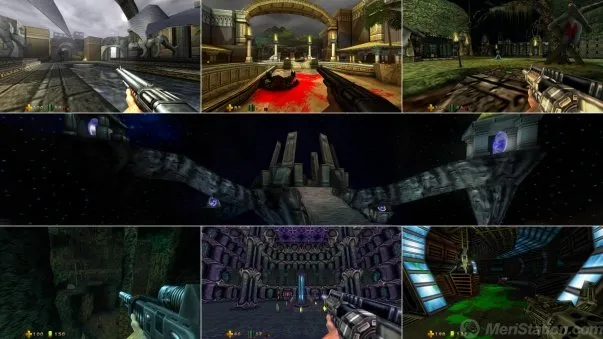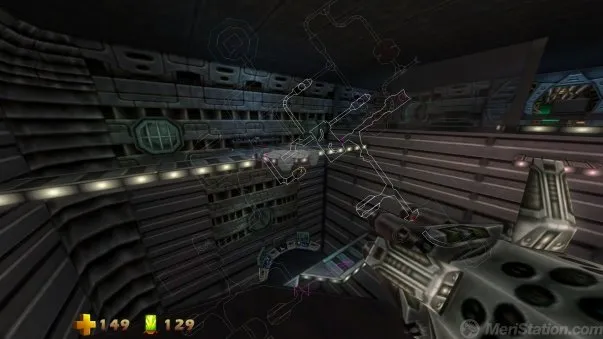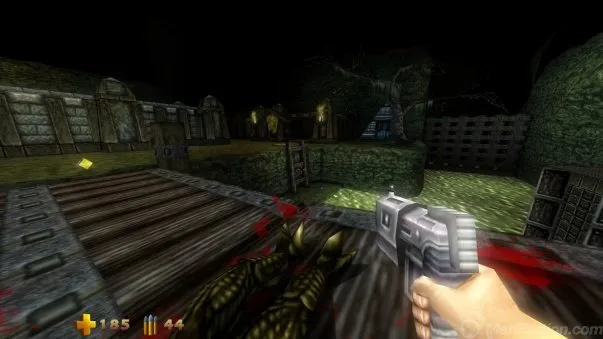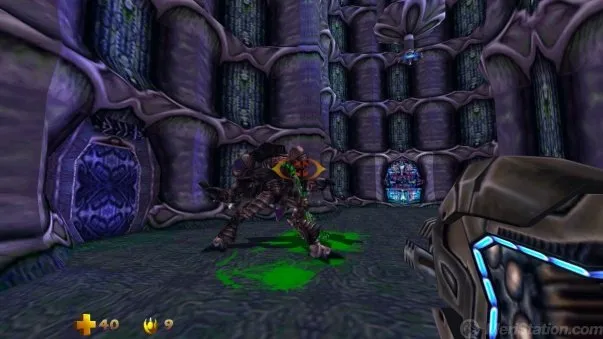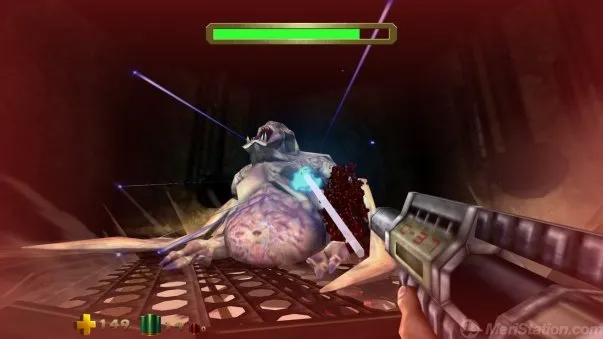CREDIT
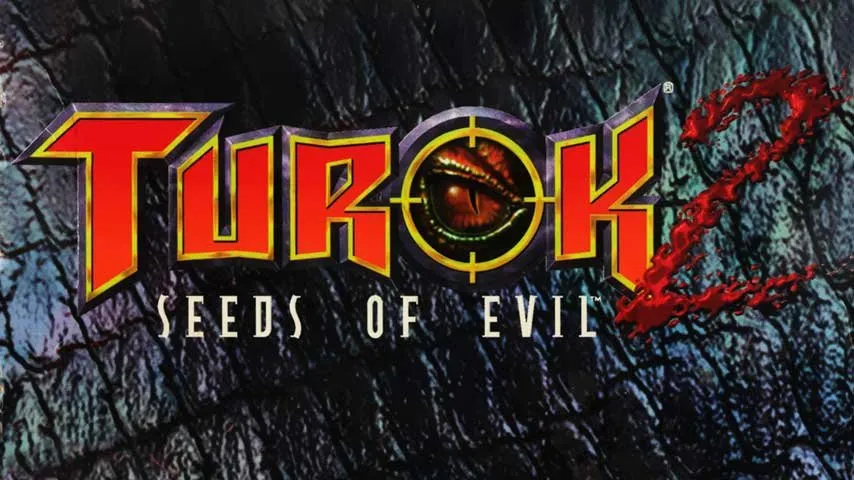
On the way to its twentieth anniversary, Turok 2 is once again a PC in a remaster that reminds us that the habits of the past can be as or more interesting than the vices of the present.
"I am Turok!"
So it may seem that this analysis is late. Turok 2: Seeds of Evil is a game from 1998, and even its re-launch in the digital platforms of PC (Steam, GoG and Humble Store) is already a few months back in time. However, even today it is easy to return some relevance to the work of Iguana Entertainmentlittle that we look around us. In a year marked by shooters with a 2 in its title (Destiny, Splatoon, Wolfenstein, Battlefront), Seeds of Evil is not only a good reminder of how a sequel can expand and improve based on its predecessor without limiting itself to making another the same time in different phases. Or how the use of a gore without reservations can give another weight to the violence, even that so exaggerated that it goes into the caricature, but without ceasing to activate something visceral in our interior. Or how the world of the game can be more than a simple succession of rooms in which to release clashes and scripts. It's all that and some other things, so it's still worth talking about in full 2017.
NightDive Studios , company responsible for bringing the titles of the extinct production company Acclaim to the 21st century, began with the difficult. True, Dinosaur Hunter had the nostalgia factor: prior to the very GoldenEye 007, it was the first incursion of many in the FPS consoleros. But while the lack of veteranía was countered with an effective and potentially addictive approach (kill dinosaurs in the jungle through a very agile gunplay ), the remaster also showed the seams of a game that even in his own generation was relegated to learning exercise barely a year and a half after its premiere. Even leaving in a post-GoldenEye panorama,Turok 2 took Nintendo 64 to limits that neither Rare nor Nintendo itself were able to achieve with most of their efforts . Like the creatures that roamed the levels, lurking in the dark to give us a claw at the slightest carelessness, Seeds of Evil was a beast capable of intimidating even the experts in the genre. A display of creativity and ambition with ideas that reach our days through other games, but that also drag the slab trying to take shape in a machine that was too small.
Risen and renewed: A necessary "remaster"
Those familiar with this classic 32-biter will know that it is already their second appearance on PC. In 1999, a few months after the launch in N64, Acclaim took Turok 2 to the platform that a priori best suited the game scheme of an FPS. However, as in other famous consoleras works of the time such as Final Fantasy VII or Metal Gear Solid, the new version was a port that did the right thing to work, taking advantage of little and nothing the possibilities offered by the jump. It may be that qualifying for remastering this reissue sounds a bit generous, since it uses the modeling and textures created by Iguanain its day (elements that do not always keep the type equally well), but at the same time the work tuning the existing base is so good that it manages to close the wound of that forgettable first port: the control has been fine-tuned, the adjustments of resolution and field of view are more flexible, the drawing distance is greater, and framerate is not a problem unless we try to move it with a very humble computer .
On these improvements are also added extra effects such as the bloom that affects the lighting, or a motion blur that causes blur in the movement of the camera and enemies if we wish. All this optional and with gradual values so that each player looks for the aspect that he wants for the game: the purists can approach the experience of yesteryear, eliminating filters and voluntarily reducing the resolution or drawing distance, while others can opt for a more modern style within the range that offers the full menu of options. The change never becomes radical , whatever we do is not going to go through a game created in 2017 (the retexturized would have been key to that),but it does succeed in its mission to offer a "vitamin port" that fans can use to replace the original , relegated to a piece of collecting now that there is a much more efficient version both visually and playable. In that sense, the recommendation is straightforward: if Turok 2 already liked you before, now you will like it more. Or at least it will be more similar to that idealized image that can be created in memory after years without visiting it.
More complicated question is what happens with those who have never played and want to immerse themselves in it without prior attachment. As we said at the beginning, we are not short of solid proposals in the field of action these days, so if any of them already has to find something differentiating or above average to gain our attention, a game of two decades has another handicap added. The positive part here, with no intention of discrediting (all) the current shooters, is that we are talking about a genre that has not always evolved as we usually understand the term. The history of the FPS is not one that is plotted in an ascending line, but rather one in which we find several compartments that have been going through their own evolutions (or involutions) a little apart from what happened around. In this way, few games such as Perfect Dark or TimeSplitters inherited the structure of GoldenEye, Half-Life marked a new path for proposals of greater narrative weight, and recently the Call of Duty campaigns made an art of choreography that creates spectacle without hardly need the player.
Turok Prime: The not so lost link
Even released near the turn of the century, Turok 2 has its origin just in the works with which Id Software institutionalized the FPS years before there was such a variety. Wolfenstein 3D and the first installments of DOOM can now look like relics of the past, but they retain that ingenuity of a time where developers lived in constant pulse with technology to build ever more complex levels. Different heights, secrets, collections and backtracking served as a complement to the shootings, establishing a symbiosis between the immediate satisfaction of gunplay and the sense of medium-term achievement to overcome or beat marks in the phases. In a stage of learning, scenographic austerity and total protagonism of the player moving the action forward, this interrelation was vital to keep interesting games beyond the first contact, although it lost some effect as new tricks appeared (playable) , visual or narrative) to stimulate us. There are few things that could be attributed to the success of the last DOOM , but one of them was precisely a reformulation of this philosophy, now relegated to the periphery of the genre.
It's hard to treat as a coincidence that Metroid Prime , the first feature by Retro Studios , is prowling that periphery. The Texan studio has part of its origins precisely in Iguana Entertainment, and Turok 2 works a bit as a link between Dinosaur Hunter and the adventures of Samus in GameCube. The original Turok raised the levels as large tracts of land, much wider than any phase of DOOM, both to give plausibility to its jungle theme (as opposed to the inferno-industrial Id Software, benefited by the feeling of claustrophobia) as for introduce plataform and facilitate the agile gunplay thanks to an action more centered in the movement than in the targeted, thus counteracting the restrictions of the command. Seeds of Evil leaves from this premise, but it makes changes of enough importance: the number of levels descends until a maximum of six to nourish more each one; the general amplitude is reduced in favor of a more intricate design, as well as provided in the use of the spaces; and the selection of environments is also better differentiated. Destroyed urbanizations, swamps, cemeteries, alien ships or colonies of insects are some of the environments that this sequel intersperses, sometimes within the same level.
Despite its extreme violence, the game makes extensive use of the color palette to give these places their own identity, creating contrasts that are then backed by the natural variation of enemies, types of structures and musical pieces . It is a title no longer richer than the original, but the majority of FPS when it comes to establishing a range of tones ranging from war to science fiction, even going through terror. This, the addition of more specific objectives that are not limited to looking for keys, and the way in which backtracking is integrated both within the worlds (for example, it is necessary to find explosives to destroy the objects required by a mission) and between they. Although the development at the beginning is relatively linear, it distributes items and skills at some levels and then use them in others, often earlier. It does not always work like a metroidvania, because although some ability is permanent (like swimming in poisonous waters without taking damage), others have very specific functions, activated in special boxes (where our protagonist can take big jumps or see invisible paths). But it is a clear approach to this terrain that even culminates in a search almost identical to the Metrozo Prime Chozo Artifact , essential for the final confrontation.
The Demon's Souls of the FPS
___Ya, ya. We will also resort to the topic of topics, but with a small nuance. Dark Souls is the game with which it is fashionable to compare everything that presents a difficulty more or less elevated (comparison of which is abused to the point of parody, although it has its logic seeing how the work of Miyazaki has encouraged others to raise the level of demand). However, in the case of Turok 2, and leaving aside the fact that it pretty much precedes the From Software series, the clearest similarities are with Demon's Souls. Despite its merits, and having a handful of followers since its launch, the Acclaim has never reached a status comparable to that of FPS as those of Rare or Bungie (saga Halo), great champions of the irruption of the genre in consoles Although more interesting for us is the small parallelism that occurs within the game, as it allows to explain its structure more clearly: like Demon's Souls, Turok 2 starts automatically on the first level (Puerto de Adia), and only after overcoming it can we enter other worlds from the small central hub , literally called The Hub in the English version.
Unlike the Nexus of Demon's Souls, here we do not find NPCs or a lady to help us level up, but we do have access to Adon , an alien girl who is responsible for presenting each world, the goals to fulfill, and also assists us with recoveries of life and ammunition once per mission. The time spent in The Hub is scarce, although it serves its purpose well to connect in some way so different phases to each other, and even allows a little flexibility when choosing the order: as Boletaria, Puerto de Adia is the first obligatory stop, but in it we can get the keys to both the second (Rio de Almas) and the third level (Marismas de la Muerte), which in turn hide the fourth and fifth respectively . Needless to say, it is not as open a structure as Demon's Souls, which allowed simultaneous access to its five regions from almost the beginning, but it does offer a certain amount of freedom when it comes to altering the game sequence, something to be grateful for. face rejugados as per the new implementation of teleportation between levels.
One of the most questionable decisions of Turok 2 in its original format was how it blocked us inside each world until it was overcome . This could be quite problematic because it meant not only having to reach the end of the level (a task that already exceeds the time of play when we are not familiar with the environment), but also to fulfill all those objectives in GoldenEye code (save imprisoned soldiers, boycotting enemy installations, etc). Otherwise, we returned to the beginning to keep looking, with the advantage of maintaining those already resolved and enjoy a quieter exploration by not regenerating most of the enemies eliminated (another big difference compared to the Souls series or even the First Turok, title of respawnsvery frequent). They are conveniences to keep in mind, but they did not completely alleviate the frustration of being blocked on a level, sometimes without knowing where to go (some goals are hidden consciously and the design becomes progressively more labyrinthic) or to take a break exploring another world to return later and face it with renewed desire. Luckily, the remasterización tries to solve it with two additions : the already mentioned teleportation, of which we will speak in a moment, and the indicators.
The indicators are small icons that highlight the position of important elements, as switches to open doors, keys or mission items. If we are close enough they can even see through the walls, which can be intrusive on the aesthetic level (there is an option to deactivate them if they bother us), but they are an extra support that surely more than one player will appreciate. Alternatively, NightDive Studios has also made some minor tweaks in the phases to facilitate the location of certain objects, although as a rule the design remains faithful and as convoluted as ever . In its day Turok 2 already offered abnormally intricate levels, full of detours, roads at various heights and some repetition of corridors or similar rooms, giving rise to an important capacity to disorient. The use of the map, drawn as we explore and superimposed on the screen so as not to interrupt the action, is almost essential and helps in many situations , although sometimes it can be short when loaded by small areas: since the game uses a multitude of teleporters to connect them , this causes a map change, which as a result works well to be oriented within them, but not so much when it comes to knowing where they are in relation to each other
The worst example of this occurs in the fourth world, Lair of the Blind, a network of caverns that goes deeper and deeper into the depths. It is an interesting idea, but it has two problems in its execution: on the one hand the transition tunnels are very abundant and similar visually, creating confusion with ease; and on the other hand, the method for lowering the floor is to throw oneself through holes that camouflage loads and force the aforementioned change in the map. The same applies to teleporters who perform the opposite function (return to the upper floor), and the game ds not do the best job communicating this up and down dynamics, so the first incursion can then become a cocoa. It is true that this is the most extreme case, and the following worlds deal better with their structural juggling,Turok 2 is not only a product of its time in terms of complexity, but also of limitations : connecting the levels with less seams or having a 3D map like the one that Metroid Prime later implemented would do wonders, but this tests the patience of the players in a way that their creators surely did not intend.
Without detracting from the work of NightDive Studios, which has definitely improved substantially the experience (although a little tug on the back of some errors in the translation), a more severe remodeling would have served to enhance the virtues that already reside in the title. Of course it would be closer to the terrain of the remake, and playing daydreaming usually serves only for that. More useful, now, is to comment onrethinking teleports between the bases that once functioned as storage points (here available at all times, another of those decisions that make life easier). It's a big change, since it allows jumping between several points of a same level in a matter of seconds to smooth backtracking , and also return to the hub or enter another level already unlocked with their corresponding keys. Returning once again to Demon's Souls, it is not far from the archipelago system that served the same purpose, although in the case of Turok 2 it is even more convenient because it does not require going through the central world on each trip. In fact, the team has even added some new bases, so when we have opened everything and arrived at the last searches, we can solve them very quickly if we know where to go.
Arsenal of weapons take
And well, then there is the issue of shooting. You know, the shooter partof the shooter. Leave it to the end may seem a contradiction, but it was necessary to emphasize that although Turok 2 serves to release adrenaline as the best of the FPS, it also sets aside that asterisk that points out that sooner or later its action can be diluted in the middle of an exploration more and more elaborate. It is a nuance important enough to devote most of the analysis (is what will ultimately decide whether people will reach the end or half way down), but does not mean that the shootings are also great. Because they are. The simple fact of having a mouse is a clear advantage over the Nintendo 64 version, and although the detection of collisions is not always at the level of modern games (it is something that is evident against smaller enemies, where you also miss the recoil that we have been accustomed to using in short distances), the movement is fast and the impact of the weapons satisfactory. As a good DOOM debtor, Turok 2He knows how to sell the forcefulness of the action through sound, animations and many, but many blood splatters .
More than its predecessor, or almost any other game, Seeds of Evil is a celebration of violence . The human enemies disappeared completely, perhaps for reasons of creativity, but possibly also to take the dismemberment to another level without dealing with censorship. The initial weapons, such as the claw, the bow or the gun, do their job without too many excesses, but from the shotgun onwards begins an escalation of cruelty that practically justifies the admission price on its own: the power of weapons such as the shotgun or the grenade launcher literally destroy the enemies, decapitating them, leaving holes in their chest, or a simple spine with legs that writhes among liters of blood; the mine thrower reaps them at the knees, causing them to crawl helplessly on the ground before dying; the cutting saw is a large blade that cuts members before returning to our hand as a boomerang; and that without forgetting the brain drill , whose projectiles adhere and suck all the contents of their heads before finishing them off with a bang. Two decades later there are still few things comparable to this masterpiece of sadistic engineering
Most weapons have advanced versions that add extra power or other advantages , such as rebounds in the projectiles of the shotgun or explosive arrows that detonate shortly after impact. This, together with a pair of exclusively aquatic use (harpoons and torpedoes), raises above twenty the number that we can carry if we find them all (Turok 2 is old school, nothing to load them in pairs). A welcome variety because although the AI was competent in its day, with differentiation between enemies that go crazy for us and other smarter looking for cover or use camouflage, currently stands out less and leaves the satisfaction of these killings so creative as the main claim. Ammunition also tends to be a precious commodity, so much for not flooding the levels with it as for preventing us from accumulating large quantities, so the game encourages us to rotate and not abuse our favorite destruction tool . As in the Breath of the Wild Breakable Weapons system (last modern comparison, promised) it can be frustrating to see how they take us out of the comfort zone every bit, but it allows us to adapt to different styles to have an experience more varied. And in the worst case, there are always the tricks ...
A little less interesting are the bosses that start to appear from the middle of the game. They are few, and although they can be memorable for their design (to highlight the gigantic mass of meat that increases the number of extremities as the fight progresses), tend to offer fairly simple combats at the mechanical level : shoot the weak spot highlighted with a different color, move so they do not hit you too much, and repeat. It is something that does not lower points either, as they season a development that without them would have fewer climatic moments, but they will hardly go down in history as one of their strong points. Almost the same can be said of the multiplayer, recovered to enjoy online, but in which today it is difficult (or impossible) to find people. As an added does not bother, and can still give us some joy if we are able to gather a group of friends to use it, but it is clear that today Turok 2 survives by and for the campaign, so it's good that it can offer to 10 to 15 working hours on your own. Long, varied and demanding, it is so typical of its time that it deserves to be remembered in ours.
conclusion
Turok 2: Seeds of Evil is not the easiest game to recommend in 2017. Not always for its shortcomings, which exist even though nostalgia sometimes wants to cloud our memory, but because it represents a philosophy of the FPS for which now It is harder to find people with patience. The revelry created by the absurd amounts of gore is still intact, but soon it takes us to worlds as big as they are intricate, full of secrets, targets at an unprivileged distance from the main road, and fissures in their ability to connect everything clearly. It is both its greatest virtue and its greatest defect, since the difference between complex and obtuse is usually a matter of perspective. On the other hand, the work of NightDive StudiosIt is very efficient when it comes to getting it done and handled as it should, but without a retexturized that modernizes it, it falls closer to the port than to the remaster. A port, yes, that adds aids and conveniences to improve both the minute to minute of the game and the development to a more global level. If you want to revisit, there is no better way to do it. And if you want to discover for the first time, either. But be careful: Oblivion is close.
The best
- The gore, deliciously exaggerated.
- Great creativity in the approach and use of some weapons.
- An ode to exploration, its levels are gigantic and convoluted.
- Some changes of this remaster make it more digestible.
- The artistic direction is more original and varied than usual in an FPS.
- The music is also at a high level and allows you to choose between the N64 and PC versions.
Worst
- At the graphic level the years weigh on it, it would have benefited from more retouching.
- Level design is sometimes not as clear or distinctive as it should be.
- The Spanish translation has some errors and does not subtitle the sequences.
Game of remarkable finish that we will enjoy and remember. A good purchase, highly recommended for lovers of the genre. It is well cared for at all levels.
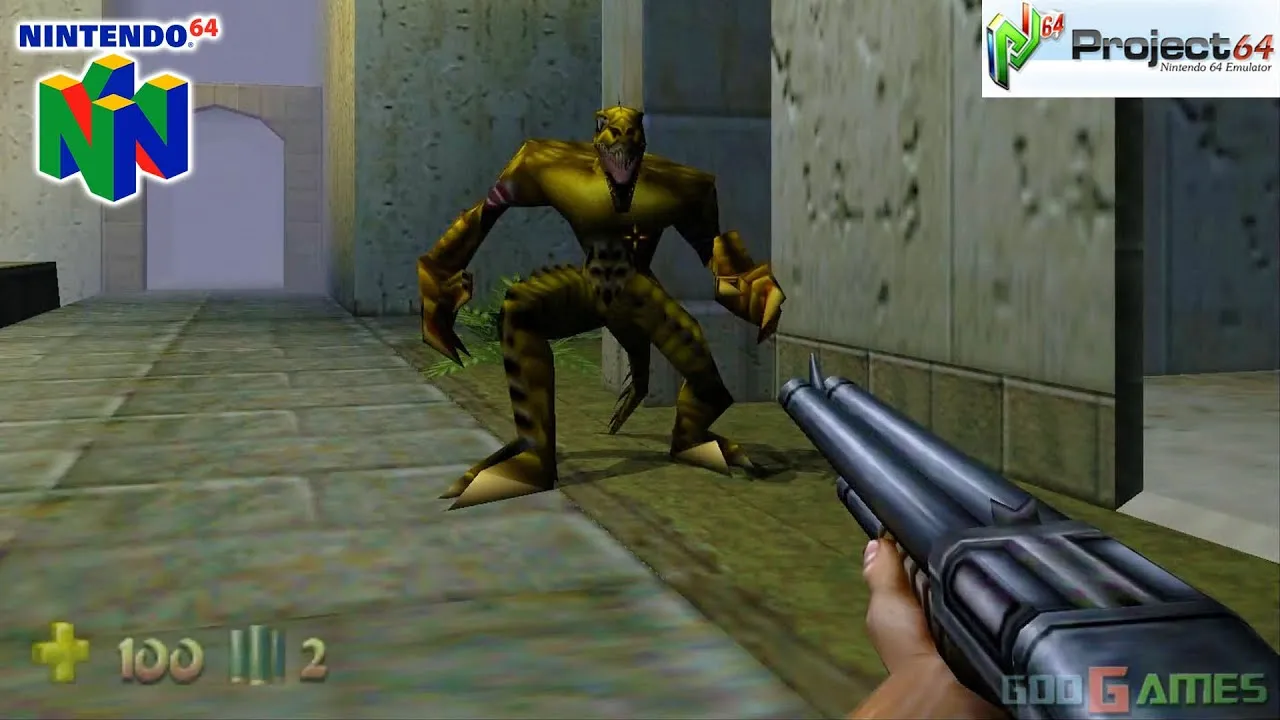
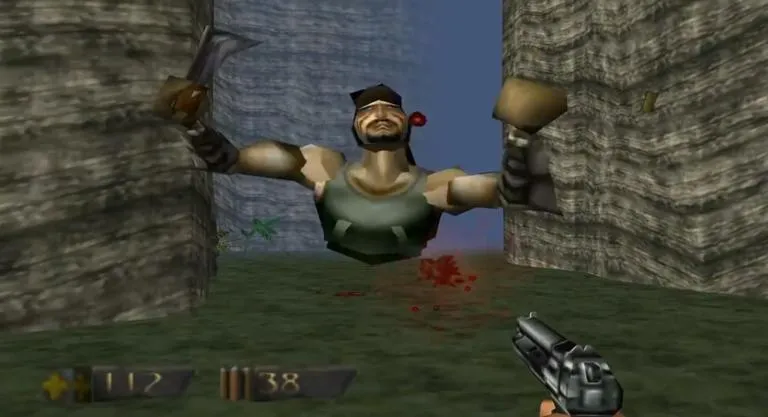 \
\
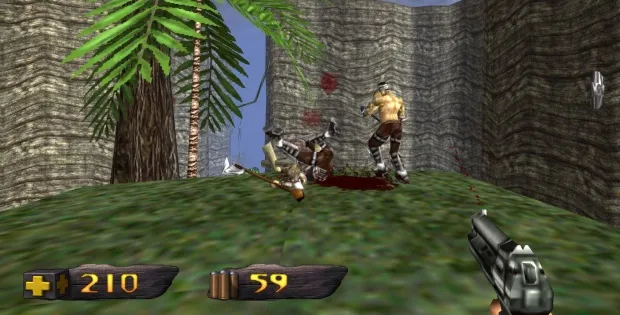
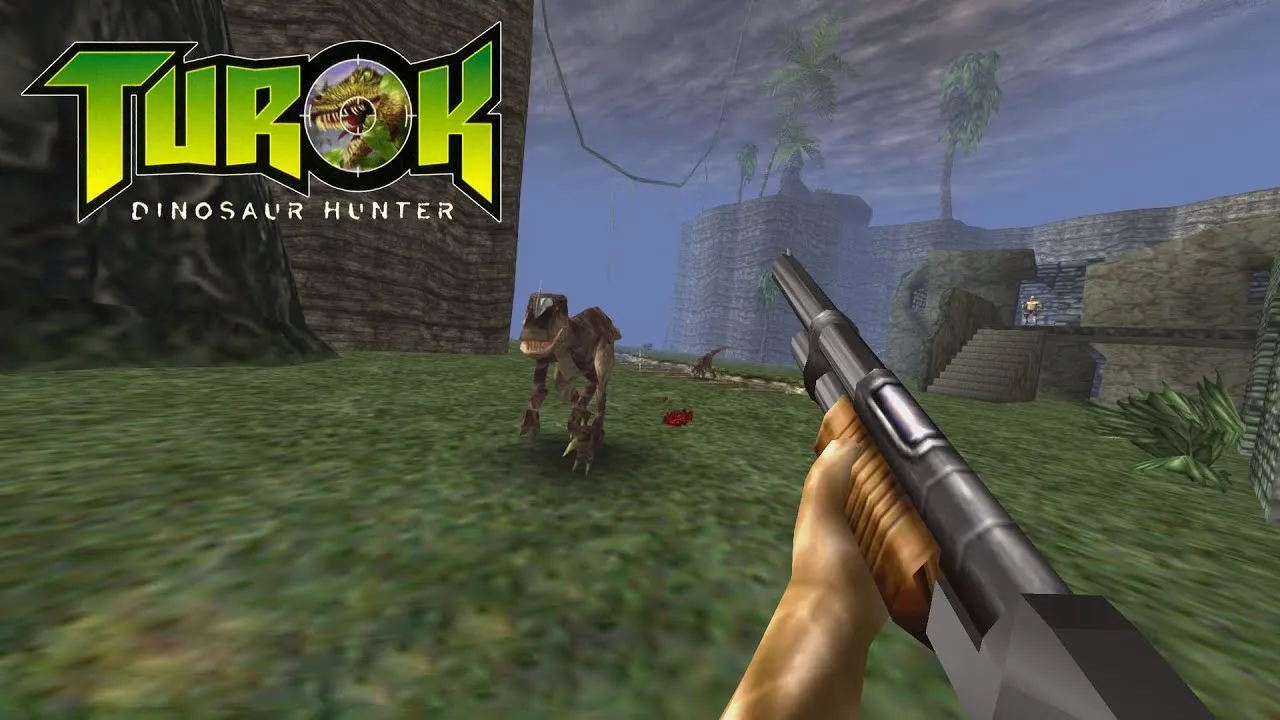
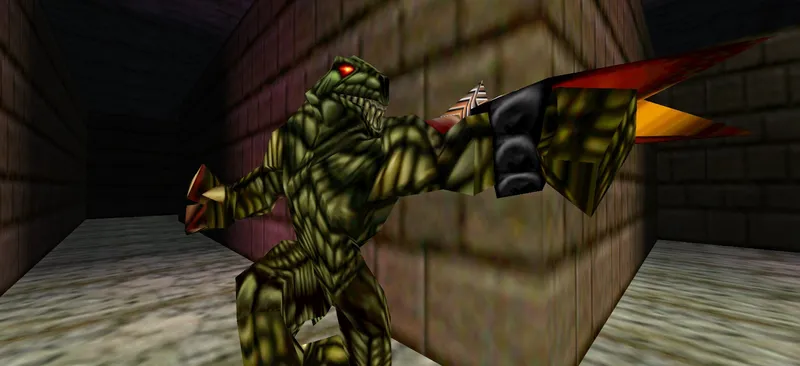
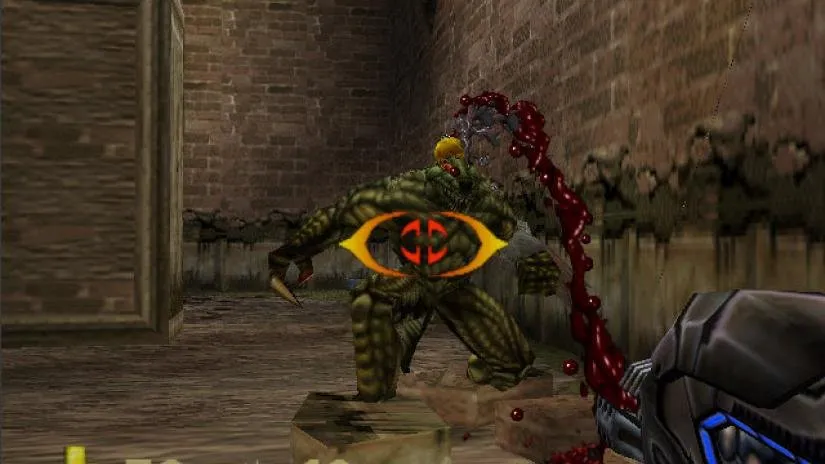
1-6 IMAGECREDIT
THANKS FOR READING, ALSO CHECK OUT MY PREVIOUS REVIEW ON RiME, analysis


